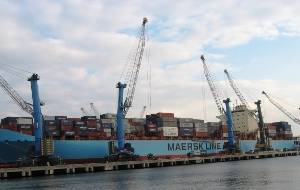Liebherr Werk-Nenzing's 2009 Results
In a highly volatile business environment, Liebherr’s Mobile Harbour Crane Division delivered satisfactory operational performance. In 2009, deliveries amounted to 74 Mobile Harbour Cranes and thus were 27% below those of the previous year’s period. In comparison the total MHC market including all manufacturers dropped ~40%. To complete the picture, this decrease has also to be put in relation with the figures of the previous years. From 2005 to 2008 LHM deliveries showed an average, annual increase of 24%, which is 16% over the total MHC market growth average.
Although the past year was one of extraordinary global economic turbulence resulting in a considerable decline in world-wide demand for mobile harbour cranes, Liebherr managed to increase its global market share substantially (+60%).
As a result of global recession, deliveries especially in Europe showed a strong decline compared to the same period in the previous year (-31%). Spain, traditionally the top selling market, was completely down, but in return other countries e.g. Russia showed a performance way above average. With 15 delivered units, Russia was by far the biggest MHC market worldwide in 2009. Although various regions are catching up, Europe still remains the most important market for mobile harbour cranes. In 2009 Liebherr could write down 35 units in its order books.
In Africa, deliveries continued to develop positively. This fact is illustrated by the supply of no less than 19 mobile harbour cranes reflecting a market share of over 70%. The fleet of African units is mainly used for container handling to cope with the constantly rising containerization of goods.
After two superior years in the Middle East deliveries dropped quite dramatically to a total of two LHMs. The maritime business was actually suffering greatly from the lack of investment by our customers. However, the first delivery to Saudi Arabia since 2003 was found to be fundamentally good.
In 2009 India was one of the key markets for Liebherr. Not only to increase their handling capacities, but also to establish a close and long lasting partnership, many port operators are turning to Liebherr technology and service. With the selling of 9 cranes in 2009 Liebherr has further boosted its excellent market position on the Indian subcontinent. Since entering the market in 2004, Liebherr has already delivered more than 40 mobile harbour cranes to India, making it the clear market leader on the Indian subcontinent.
Sales in Far East and the Pacific region respectively reached 2 units, but overall economic development showed the first signs of an upwards trend in the third quarter of 2009. This could be seen primarily in Asia. China’s and Korea’s growth continued and also Japan made slight progress.
Also in Latin America (5 units) deliveries suffered a severe setback. Especially in Brazil the market was almost completely down last year, although the crisis was considered rather mild there. Brazilian ports are known for pulling the brake with any sign of uncertainty, waiting for circumstances to get clearer, but signs show now that the market is moving again. With two delivered machines North America leveled off just under the five-year average.
Technology remains central to Liebherr’s efforts to manufacture Mobile Harbour Cranes. Over the next year, Liebherr is set to increase its efforts to provide tailor-made MHC such as barge or portal solutions. With six rail mounted portal cranes (LPS) delivered, 2009 definitely was a benchmark for Liebherr’s future sales ambitions. All LPS are equipped with an electric prime mover, which makes it possible to run the crane on electricity from an external source at the port.
All Liebherr Mobile Harbour Cranes are equipped with a hydrostatic drive system. The simple hydrostatic drives remain standard, allowing the same components to be used throughout the whole range (LHM 120 – LHM 600) and ensure high spare parts availability and a single system for engineering support.
In addition, the hydrostatic systems have a very low “moment of inertia” providing extremely fast acceleration times. Liebherr Mobile Harbour Cranes attain a hoist speed of 120 m/min in less than 3 seconds, around a fourth or fifth of the time of a comparable linear DC machine. Hydrostatic units are one synchronous system. This doesn’t just add a general robustness; energy is easily recaptured from the crane's braking and lowering motions. Further, it avoids the power loss that you get through transiting to other energy modes like the loss involved in the banks of electrical resistors, for example.
Standard prime mover of the hydrostatic drive system is a diesel engine, i.e. the cranes are able to work completely autonomous. Of course, all LHM models can also be equipped with an electric main drive. If the port has a quay side installation for shore power supply available, the crane can be operated directly with power from the harbour mains.
Liebherr’s spending on research and development has again increased as Liebherr develops new ecologically sensitive technologies. Despite the economic crisis, the focus on reducing CO² remains important. Liebherr is involved in a number of projects helping to advance technology to decrease CO².















